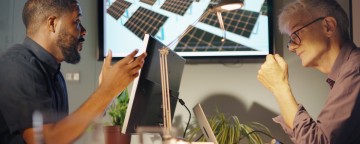Businesses today urgently need to become more resilient in the face of disrupted supply chains and the scarcity of raw materials. Circular design offers businesses a tangible solution to become part of a low-carbon, inclusive, and resilient economy by rethinking their offer in a systemic way.
Ecodesign

Businesses today urgently need to become more resilient in the face of disrupted supply chains and the scarcity of raw materials. Circular design offers businesses a tangible solution to become part of a low-carbon, inclusive, and resilient economy by rethinking their offer in a systemic way.
80%* of a product’s overall environmental impact is determined during the design phase.
What is circular design?
Circular design is directly linked to the concept of the circular economyThe circular economy is a restorative and regenerative economy. By maintaining the value of the products, materials and resources in the economy through smart product design, repurposing and/or shared use of products, it reduces the extraction of natural resources by using resources already present in the economy.. It entails the development of sustainable products or services that consider the entire life cycle, rethinking each key stage: the design, the choice of materials, production and distribution processes, the use phase, and recovery at end-of-life. Circular design decoupleA product lifecycleA product lifecycle takes into account every activity involved in the manufacture, use, transport and disposal of the product. takes into account every activity involved in the manufacture, use, transport and disposal of the product.s economic growth from resource consumption, by ensuring products and materials circulate at their highest value.
Ecodesign vs. circular design
Ecodesign broadens the scope of circular design by applying its principles to entire product or service systems and strategic business decisions, in order to create sustainable and circular business models. It encompasses any form of design that reduces the environmental impact of the products or services developed.
Principles of circular design
The circular design approach is based on several key principles:
- prioritising local and/or abundant resources that can be reuseReuse designates all operations by which substances, materials or products that are not waste are used again in an identical way to their originally intended purpose.d and recycled without compromising quality;
- optimising resources and energy efficiencyEfficiency is focused on the productivity of resources, i.e. in an improvement in the relationship between the natural resources used and the benefit they provide in the form of a product manufactured or a service provided. in product design;
- considering factors such as durability, longevity, repairRepair is making a faulty product work again, allowing its use to be extended without the user parting with it, or with a view to reuse (donation, second-hand sale).ability, and reuse of the product during its life cycle;
- incorporating new – mainly digital – economic models, in which consumers become users;
- anticipating the dismantling of the product through recyclingAny recovery operation through which waste, including organic waste, is reprocessed to become substances, materials or products that can be used for their initial function or other functions. and upcyclingUpcycling consists of transforming waste into higher quality products. if the previous principles do not suffice for the reintegration of materials into the life cycle;
- envisioning a waste-free life cycle of the service or product and its components;
- defining a continuous improvement process: understand/define/make/go to market.
Resources, products, services, system: circular design can intervene on different levels
Circular design can apply to both products and services, as well as the overall organisation, helping us to rethink workplaces, travel, catering, digital operations, etc.
It can therefore be implemented at different levels:
- Resources: creating new materials or components made from these resources, redesigning existing resources;
- Product: improving an existing product or developing entirely new product solutions;
- Service: going beyond the individual product to develop product-service systems (PSS);
- System: considering all of the interconnected elements and organising them coherently to achieve a function or an objective.
The chosen strategies thus depend on the scope of selected intervention.
Further reading
The circular design guide was developed for current and future designers, business owners, and innovators in the broadest sense.
It provides a step-by-step approach to the creative process, through 24 methods.
Design leaders: what does Circular Design mean to them?